|
|
|
Ray
Carney's Bookstore
Click
here for best printing
of text
|
| Cassavetes
on Cassavetes |
$25 |
|
| The
Films of John Cassavetes: Pragmatism, Modernism, and the Movies |
$20 |
| John
Cassavetes: The Adventure of Insecurity |
$15 |
| Shadows |
$20 |
| Collected
Essays on the Life and Work of John Cassavetes |
$15 |
| "Special
Issue: John Cassavetes." PostScript: Essays in Film
and the Humanities |
$10 |
| A
Detective Story – Going Inside the Heart and Mind of the Artist:
A Study of Cassavetes' Revisionary Process in the Two Versions of
Shadows |
$15 |
| American
Dreaming: The Films of John Cassavetes and the American Experience |
$20 |
| Why
Art Matters: A collection of essays, interviews, and lectures on life
and art |
$15 |
| Necessary
Experiences—What art can show us about ourselves and our culture |
$15 |
| What's
Wrong with Film Courses, Film Criticism, and Film Reviewing—And
How to Do It Right |
$15 |
| A
Modern Mosaic: Art and Modernism in the United States |
$29 |
| The
Revival of Pragmatism: New Essays in Social Thought, Law, and Culture |
$25 |
| The
Films of Mike Leigh: Embracing the World |
$20 |
| American
Vision: The Films of Frank Capra |
$20 |
| Speaking
the Language of Desire: The Films of Carl Dreyer |
$20 |
| Learning
from Dreyer: Reflections on the Lessons His Work Teaches |
|
| Beat
Culture and the New America—1950-1965 |
|
| Your Life is a Movie: Alternative Visions of Film, Media, and Culture |
| To
purchase any of these books with a check or money order or through
PayPal, please click here. |
Ray
Carney, Cassavetes on Cassavetes (Faber and Faber in London, and
Farrar, Straus and Giroux in New York), copiously illustrated, paperback,
approximately 550 pages. Available directly from the author for $25.
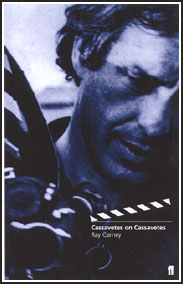 Cassavetes
on Cassavetes is the autobiography John Cassavetes never lived to
write. It tells an extraordinary saga – thirty years of film history, chronicling
the rise of the American independent movement – as it was lived by
one of its pioneers and one of the most important artists in the history of
the medium. The struggles, the triumphs, the crazy dreams and frustrations
are all here, told in Cassavetes' own words. Cassavetes on Cassavetes
tells the day-by-day story of the making of some of the greatest and most
original works of American film. —from the "Introduction:
John Cassavetes in His Own Words" Cassavetes
on Cassavetes is the autobiography John Cassavetes never lived to
write. It tells an extraordinary saga – thirty years of film history, chronicling
the rise of the American independent movement – as it was lived by
one of its pioneers and one of the most important artists in the history of
the medium. The struggles, the triumphs, the crazy dreams and frustrations
are all here, told in Cassavetes' own words. Cassavetes on Cassavetes
tells the day-by-day story of the making of some of the greatest and most
original works of American film. —from the "Introduction:
John Cassavetes in His Own Words"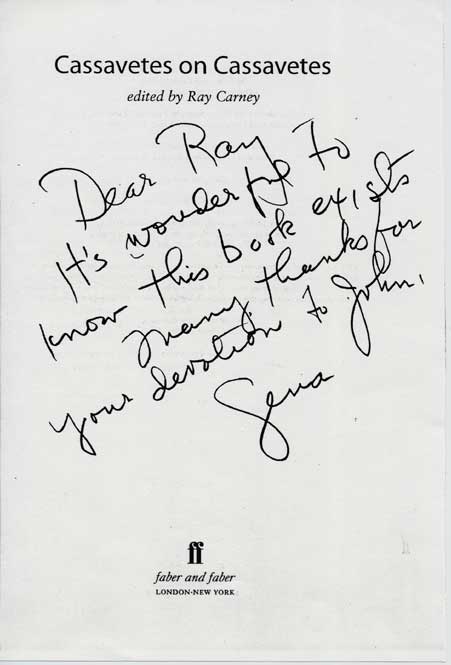
Click here to access a detailed description of the book and a summary
of the topics covered in it.
To read reviews and critical responses to Ray Carney's Cassavetes on Cassavetes, please click here.
Cassavetes
on Cassavetes is available in the United States through Amazon
and Barnes
and Noble, and in England through Amazon
(UK), Faber
and Faber (UK). It is also available at your local bookseller, or,
for a limited time, directly from the author (in discounted, specially
autographed editions) for $25 via this web site. See
below for information how to order this book directly from this web site
by money order, check, or credit card (using PayPal).
* * *
Ray
Carney, The Films of John Cassavetes: Pragmatism, Modernism, and the
Movies
(New York and Cambridge: Cambridge University Press, 1994), 48 illustrations,
paperback, 322 pages. This book is available directly from the author
for $20.
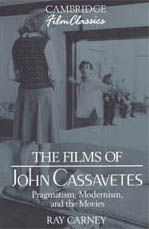
The Films of John Cassavetes tells the inside story of the making
of six of Cassavetes' most important works: Shadows, Faces,
Minnie and Moskowitz, A Woman under the Influence, The
Killing of a Chinese Bookie, and Love Streams.
With the help of almost fifty
previously unpublished photographs from the private collections of Sam
Shaw and Larry Shaw, and excerpts from interviews with the filmmaker and
many of his closest friends, the reader is taken behind the scenes to
watch the maverick independent at work: writing his scripts, rehearsing
his actors, blocking their movements, shooting his scenes, and editing
them. Through words and pictures, Cassavetes is shown to have been a deeply
thoughtful and self-aware artist and a profound commentator.
This iconoclastic, interdisciplinary
study challenges many accepted notions in film history and aesthetics.
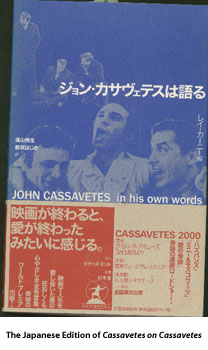 Ray
Carney argues that Cassavetes' films participate in a previously unrecognized
form of pragmatic American modernism that, in its ebullient affirmation
of life, not only goes against the world-weariness and despair of many
twentieth-century works of art, but also places his works at odds with
the assumptions and methods of most contemporary film criticism. Ray
Carney argues that Cassavetes' films participate in a previously unrecognized
form of pragmatic American modernism that, in its ebullient affirmation
of life, not only goes against the world-weariness and despair of many
twentieth-century works of art, but also places his works at odds with
the assumptions and methods of most contemporary film criticism.
Cassavetes' films are provocatively
linked to the philosophical writing of Ralph Waldo Emerson, William James,
and John Dewy, both as an illustration of the artistic consequences of
a pragmatic aesthetic and as an example of the challenges and rewards
of a life lived pragmatically. Cassavetes' work is shown to reveal stimulating
new ways of knowing, feeling, and being in the world.
For reviews and
critical responses to The Films of John Cassavetes, please click
here.
This book is available through Amazon, Barnes
and Noble, your local bookseller, or, for a limited time, directly
from the author (in discounted, specially autographed editions).
See below for information how
to order this book directly from the author by money order, check, or
credit card.
Clicking on the above links
will open a new window in your browser. You may return to this page by
closing that window or by clicking on the window for this page again.
* * *
Ray
Carney, John Cassavetes: The Adventure of Insecurity
(Boston: Company C Publishing, 1999), 25 illustrations, paperback, 68
pages. This book is available directly from the author for $15.
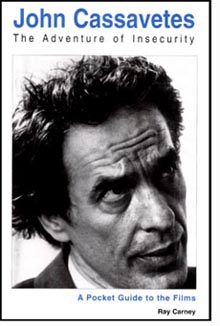 |
-
New
essays on all of the major films, including Shadows,
Faces, Husbands, Minnie and Moskowitz,
A Woman Under the Influence, The Killing of a Chinese
Bookie, Opening Night, and Love Streams
-
New,
previously unknown information about Cassavetes' life and working
methods
-
A
new, previously unpublished interview with Ray Carney about
Cassavetes the person
-
Statements
about life and art by Cassavetes
-
Handsomely
illustrated with more than two dozen behind-the-scenes photographs
Click
here to access a detailed description of the book.
|
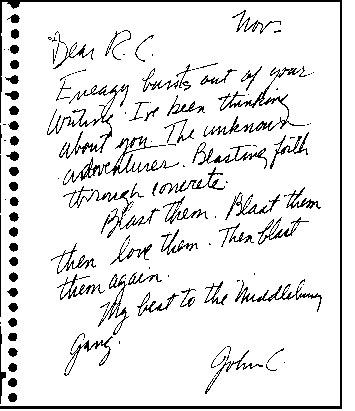 This book is available through
Amazon,
Barnes
and Noble, your local bookseller, or, for a limited time, directly
from the author (in discounted, specially autographed editions).
See below for information how
to order this book directly from the author by money order, check, or
credit card. This book is available through
Amazon,
Barnes
and Noble, your local bookseller, or, for a limited time, directly
from the author (in discounted, specially autographed editions).
See below for information how
to order this book directly from the author by money order, check, or
credit card.
Clicking on the above links
will open a new window in your browser. You may return to this page by
closing that window or by clicking on the window for this page again.
* * *
Ray
Carney, Shadows (BFI Film Classics, ISBN: 0-85170-835-8),
88 pages. This book is available directly from the author
via this web site for $20.
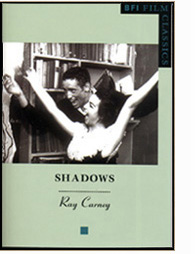
"Ray Carney is
a tireless researcher who probably knows more about the shooting of
Shadows than any other living being, including Cassavetes when
he was alive, since Carney, after all, has the added input of ten
or more of the film’s participants who remember their own unique
versions of the reality we all shared."—Maurice
McEndree, producer and editor of Shadows
"Bravo! Cassavetes
is fortunate to have such a diligent champion. I am absolutely dumbfounded
by the depth of your research into this film.... Your appendix...is
a definitive piece of scholarly detective work.... The Robert Aurthur
revelation is another bombshell and only leaves me wanting to know more....
The book movingly captures the excitement and dynamic Cassavetes discovered
in filmmaking; and the perseverance and struggle of getting it up there
on the screen."—Tom
Charity, Film Editor, Time Out magazine
John Cassavetes’ Shadows
is generally regarded as the start of the independent feature movement
in America. Made for $40,000 with a nonprofessional cast and crew and
borrowed equipment, the film caused a sensation on its London release
in 1960.
The film traces the lives of
three siblings in an African-American family: Hugh, a struggling jazz
singer, attempting to obtain a job and hold onto his dignity; Ben, a Beat
drifter who goes from one fight and girlfriend to another; and Lelia,
who has a brief love affair with a white boy who turns on her when he
discovers her race. In a delicate, semi-comic drama of self-discovery,
the main characters are forced to explore who they are and what really
matters in their lives.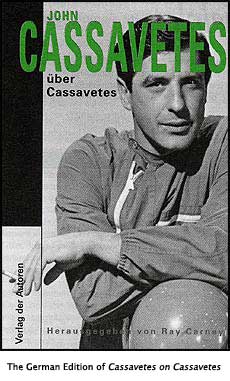
Shadows ends with the
title card "The film you have just seen was an improvisation," and
for decades was hailed as a masterpiece of spontaneity, but shortly
before Cassavetes’ death, he confessed to Ray Carney something
he had never before revealed – that much of the film was scripted. He
told him that it was shot twice and that the scenes in the second version
were written by him and Robert Alan Aurthur, a professional Hollywood
screenwriter. For Carney, it was Cassavetes‘ Rosebud. He spent
ten years tracking down the surviving members of the cast and crew, and
piecing together the true story of the making of the film.
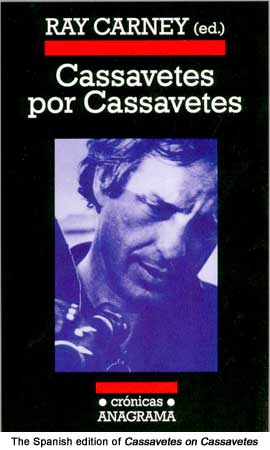 Carney takes the reader behind
the scenes to follow every step in the making of the movie – chronicling
the hopes and dreams, the struggles and frustrations, and the ultimate
triumph of the collaboration that resulted in one of the seminal masterworks
of American independent filmmaking. Carney takes the reader behind
the scenes to follow every step in the making of the movie – chronicling
the hopes and dreams, the struggles and frustrations, and the ultimate
triumph of the collaboration that resulted in one of the seminal masterworks
of American independent filmmaking.
Highlights of the presentation
are more than 30 illustrations (including the only existing photographs
of the dramatic workshop Cassavetes ran in the late fifties and of the
stage on which much of Shadows was shot, and a still showing a
scene from the "lost" first version of the film); and statements by many
of the film's actors and crew members detailing previously unknown events
during its creation.
One of the most interesting and original aspects of the book is a nine-page Appendix that "reconstructs" much of the lost first version of the film for the first time. The Appendix
points out more than 100 previously unrecognized differences between the
1957 and 1959 shoots, all of which are identified in detail both by the
scene and the time at which they occur in the current print of the movie
(so that they may be easily located on videotape or DVD by anyone viewing
the film).
By comparing the two versions,
the Appendix allows the reader to eavesdrop on Cassavetes' process of
revision and watch his mind at work as he re-thought, re-shot, re-edited
his movie. None of this information, which Carney spent more than five
years compiling, has ever appeared in print before (and, as the presentation
reveals, the few studies that have attempted to deal with this issue prior
to this are proved to have been completely mistaken in their assumptions).
The comparison of the versions and the treatment of Cassavetes' revisionary
process is definitive and final, for all time.
For reviews and critical
responses to Ray Carney's book on the making of Shadows,
please click
here.
This book is available through Amazon,
Barnes
and Noble, and in England through Amazon
(UK) and The
British Film Institute. For a limited time, the Shadows book
is also available directly from the author (in discounted, specially autographed
editions) via this web site. See
information below on how to order this book directly from the author by
money order, check, or credit card (PayPal). 
Clicking on the above links
will open a new window in your browser. You may return to this page by
closing that window or by clicking on the window for this page again.
Ray Carney, American
Dreaming: The Films of John Cassavetes and the American Experience (Berkeley: University of California Press, 1985). $20.
[From the original dust jacket
description:] John Cassavetes is known to millions of filmgoers as
an actor who has appeared in Rosemary’s Baby, The
Dirty Dozen, Whose Life Is It, Anyway?, Tempest,
and many other Hollywood movies. But what is less known is that Cassavetes
acts in these films chiefly in order to finance his own unique independent
productions. Over the past 25 years, working almost entirely outside
the Hollywood establishment, Cassavetes has written, directed, and
produced ten extraordinary films. They range from romantic comedies
like Shadows and Minnie and Moskowitz to powerful,
poignant domestic dramas like Faces and A Woman Under
the Influence to unclassifiable emotional extravaganzas like Husbands, The
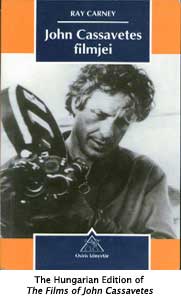 Killing
of a Chinese Bookie, and Gloria. Killing
of a Chinese Bookie, and Gloria.
This is the first book-length
study ever devoted to this controversial and iconoclastic filmmaker.
It is the argument of American Dreaming that Cassavetes has
single-handedly produced the most stunningly original and
important body of work in contemporary film. Raymond Carney examines
Cassavetes’ life and work in detail, traces his break with Hollywood,
and analyzes the cultural and bureaucratic forces that drove him to
embark on his maverick career. Cassavetes' work is considered in the
context of other twentieth-century forms of traditional and avant-garde
expression and is provocatively contrasted with the better-known
work of other American and European filmmakers.
The portrait of John Cassavetes
that emerges in these pages is of an inspiringly idealistic American
dreamer attempting to beat the system and keep alive his dream of personal
freedom and individual expression – just as the characters in
the films excitingly try to keep alive their middle-class dreams
of love, freedom, and self-expression in the hostile emotional
and familial environments in which they function. His films are chronicles
of the yearnings, desires, and frustrations of the American dream.
He is America’s truest historian of the inevitable conflict between the ideals and the realities of the American experience.
"By far the
most thorough, ambitious, and far-reaching criticism of Cassavetes'
work has been accomplished by Raymond Carney, currently Professor
of Film and American Studies at Boston University. Carney wrote the
first book-length study of  Cassavetes,
who languished in critical obscurity until the publication of Carney's American
Dreaming in 1985.... In Carney's view, to settle the accounts
of our lives, to decide once and for all, is, for Cassavetes, to tumble
headlong into the abyss of nonentity upon which we incessantly verge.
Carney argues that Cassavetes has re-invented the craft of filmmaking
in ways that drastically alter our casual habits of film viewing.
To adapt William James' terminology (which Carney is indebted to)
Cassavetes' works are concerned less with the events and finished
episodes that make up the 'substantive' parts of our experience
and more with the moments of insecurity, the 'transitive' slippages
during which our habitual strategies for understanding and stabilizing
our relationships with ourselves and others cease to function in any
useful way.... Carney's work with Cassavetes, placed within the context
of his later book, American Vision, on Frank Capra, can be
viewed as an attempt not only to further the understanding of American
film, but to forge a new synthesis of understanding in American Studies,
making his critical works valuable not only to film scholars, but
to students of American culture generally." — Lucio
Benedetto, PostScript Magazine Cassavetes,
who languished in critical obscurity until the publication of Carney's American
Dreaming in 1985.... In Carney's view, to settle the accounts
of our lives, to decide once and for all, is, for Cassavetes, to tumble
headlong into the abyss of nonentity upon which we incessantly verge.
Carney argues that Cassavetes has re-invented the craft of filmmaking
in ways that drastically alter our casual habits of film viewing.
To adapt William James' terminology (which Carney is indebted to)
Cassavetes' works are concerned less with the events and finished
episodes that make up the 'substantive' parts of our experience
and more with the moments of insecurity, the 'transitive' slippages
during which our habitual strategies for understanding and stabilizing
our relationships with ourselves and others cease to function in any
useful way.... Carney's work with Cassavetes, placed within the context
of his later book, American Vision, on Frank Capra, can be
viewed as an attempt not only to further the understanding of American
film, but to forge a new synthesis of understanding in American Studies,
making his critical works valuable not only to film scholars, but
to students of American culture generally." — Lucio
Benedetto, PostScript Magazine
For reviews and critical responses to Ray Carney's American Dreaming: The Films of John Cassavetes, please click here.
This was the first book ever written about Cassavetes' life and work in any language, and has long been out of print but is now newly available through
this web site for $20 in a Xerox of the original edition. You
may order with a credit card through PayPal or through the mail
with a money order. See below.
* * *
In addition,
two packets of Ray Carney's writings
on John Cassavetes (material not included in any of the above books)
are also specially available
through
this web site. These packets contain the texts of many of his notes and
essays about the filmmaker. Each packet is available for $15.00.
Collected
Essays on the Life and Work of John Cassavetes (a packet of essays
by Ray Carney previously published in magazines, newspapers, and periodicals
and now unavailable). Approximately 130 pages. A loose-leaf
bound packet of Ray Carney's writings on John Cassavetes is specially
available only through this web site. The packet has the complete texts
of program notes and essays about Cassavetes that were published by
Ray Carney in a variety of film journals and general interest periodicals
between 1989 and the present. It contains more than fifteen separate
pieces – including the keynote essay commissioned by the Sundance
Film Festival for their retrospective of Cassavetes' work at the time
of his death as well as the memorial piece on Cassavetes awarded a
prize by The Kenyon Review as "one of the best essays of the
year by a younger author."
This packet also
contains the text Ray Carney contributed to the "Special John
Cassavetes Issue" of PostScript edited
by Ray Carney, including "A Polemical Introduction: The Road Not
Taken," "Seven Program Notes from the American Tour of the
Complete Films: Faces, Minnie and Moskowitz, Woman
Under the Influence,
The Killing of a Chinese Bookie, and Love Streams."
The Collected
Essays on the Life and Work of John Cassavetes is not for
sale in any store, and available exclusively on this web site for $15.00
under the same credit payment terms or at the same mailing address
as the other offers.
***
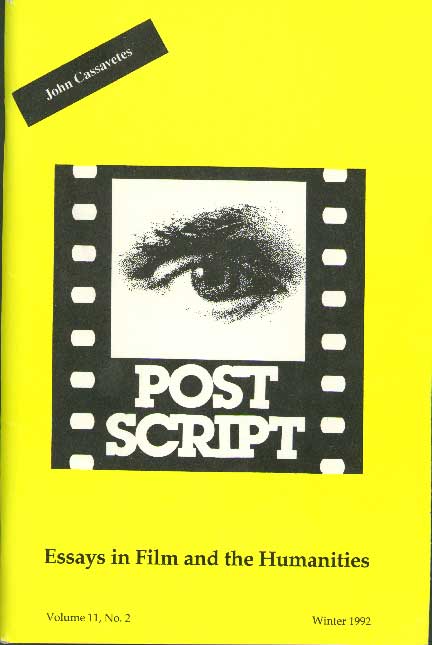 "Special Issue: John Cassavetes." PostScript:
Essays in Film and the Humanities Vol. 11 Number 2 (Winter 1992). Guest
editor: Ray Carney $10. "Special Issue: John Cassavetes." PostScript:
Essays in Film and the Humanities Vol. 11 Number 2 (Winter 1992). Guest
editor: Ray Carney $10.
Handsomely illustrated. 113 double-column pages (50,000 words).
A memorial tribute to the life and work of John Cassavetes. Essays by
Ray Carney, George Kouvaros, Janice Zwierzynski, and Carole Zucker. Interviews
with Al Ruban and Seymour Cassel by Maria Viera. A history of the critical
appreciation of Cassavetes' work and a bibliography of writing in English
by Lucio Benedetto. The issue is illustrated with more than 40 behind-the-scenes
photos of Cassavetes and his actors and contains many personal statements
by him about his life and work.
This
issue includes eight essays by Ray Carney about Cassavetes' life and
work: "A Polemical Introduction: The Road Not Taken," and "Seven
Program Notes from the American Tour of the Complete Films, about Faces,
Minnie and Moskowitz, Woman Under the Influence, The
Killing of a Chinese Bookie, and Love Streams." But
note that Ray Carney's contributions to the special Cassavetes issue
of PostScript magazine are also available
as part of the packet, The Collected Essays on the Life and Work
of John Cassavetes, which contains many other pieces by Prof.
Carney as well. The Collected Essays packet is listed separately above at a price
of $15. But if you would like a Xerox copy of the entire PostScript magazine issue (which includes the other additional material by the
other authors listed above), the PostScript issue is available
separately for $10. You may order it with a credit card through PayPal
or through
the mail with a money order. See the instructions below. ***
A
packet comparing the two versions of Shadows is available: A
Detective Story – Going Inside the Heart and Mind of the Artist: A Study of Cassavetes'
Revisionary Process in the Two Versions of Shadows. Available direct
from the author through this site for $15.
This packet contains the following
material (most of which was not included in the BFI Shadows book):
- An introductory essay about
the two versions of the film
- A table noting the minute-by-minute,
shot-by-shot differences in the two prints. (In the British Film Institute
book on Shadows, this table appears in a highly abridged, edited
version, at less than half the length and detail presented here.)
- A conjectural reconstruction
of theshot sequence in the 1957 print
- A shot list for the 1959
re-shoot of the film
- The credits exactly as presented
in the film (including typographical and orthographical vagaries indicating
Cassavetes' view of the importance of various contributors)
- An expanded and corrected credit listing that includes previous uncredited actors and appearances (e.g. Cassavetes in a dancing sequence; Gena Rowlands in a chorus girl sequence; and Danny Simon and Gene Shepherd in the nightclub sequence)
- Notes about the running
times of both versions and information about dates and places of early
screenings
- A bibliography of suggested
additional reading (including a note about serious mistakes in previous
treatments of the film by other authors)
Very little of
this material was included in the BFI book on Shadows due to limitations
on space. This 85-page (25,000 word) packet is not for sale in any store
and is available exclusively through this site for $15.
*** |
|
Telling
the Truth about Life and Art
Three packets of interviews
with Ray Carney are available exclusively through www.Cassavetes.com.
They are not for sale in any store and only available through this web
site.
In them Ray Carney talks about —
- the importance
of art in a world organized around business values
- the importance
of the unique, individual voice in a world of averages and generalizations
- the importance
of excellence in a world of mediocrity
- the importance
of truth–telling in a world devoted to popularity and celebrity
- the difference
between teaching content (facts, methods, and techniques) and teaching
ways of knowing
- what’s
wrong with the study of film in college and graduate school
- why most film
books and film reviews are so bad
Ray Carney, Why
Art Matters: A collection of essays, interviews, and lectures on
life and art, softbound, approximately 150 pages (60,000 words).
Available for $15.
A collection of essays, interviews,
and lectures on art, life, and film that appeared in Visions and Moviemaker magazines
between 1993 and 1999. The collection includes the celebrated “The
Rules of the Game,” “Fake Independence and Real Truth,” “The
Path of the Artist,” and many additional pieces. This packet
reprints the complete texts of many items that are published only in
excerpts on Ray Carney’s site.
* *
*
Ray Carney, Necessary
Experiences—What art can show us about ourselves and our
culture, softbound, approximately 170 pages (60,000 words).
Available for $15.
A collection of essays and
interviews on art, life, and independent film that appeared in Filmmaker, Moviemaker, The
Daily Telegraph, and other places between 1999 and 2002. Ray Carney
talks with Jim McKay, Cynthia Rockwell, Jake Mahaffy, and others about
his impressions of Cassavetes the man, and about the lessons he learned
while working on his Cassavetes on Cassavetes and Shadows books.
He talks with Shelley Friedman about independent filmmaking and the
importance of making a life when making a career. This packet reprints
the complete texts of many items that are published only in excerpts
on Ray Carney’s web site.
* *
*
Ray Carney, What's
Wrong with Film Books, Film Courses, and Film Reviewing—And
How to Do It Right, softbound, approximately 190 pages (80,000
words). Available for $15.
A book-length interview in
which Ray Carney talks about his experiences as a classroom teacher,
his views of the American media and film reviewing system, and his
experiences in the world of publishing. The complete interview will
be published in two parts. Part one is now available. Check back for
the availability of part two in the near future. This packet reprints
the complete texts of many items that are published only in excerpts
on Ray Carney’s web site.
* *
*
Ray
Carney has the longest and most ambitious essay he has ever written about
film and philosophy in the following book. The essay is more than 40,000
words long.
A Modern Mosaic: Art and Modernism in the United
States, Edited by Townsend Ludington
(University of North Carolina Press, 2000), 225 b&w illustrations, paperback,
472 pages. This
book is available directly from this site for $29.
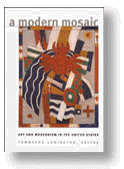 |
The modernist movement
has shaped our era as has no other. This insightful collection of
original essays explores the impact of modernism on American culture
and the ways in which modernism remains a key to understanding American
art and society.
An impressive cast of
scholars examines works and their creators across the whole spectrum
of artistic expressionfiction and poetry, painting and sculpture,
architecture, dance, photography, and film. In fresh and provocative
essays they explore how the ideas of modernism helped shape such
artistic expressions as the writings of the Harlem Renaissance,
the paintings of Edward Hopper, New Deal public art projects, and
George Antheil's Ballet Mecanique. Extensive use of color and black-and-white
illustrations results in a book that is as appealing visually as
it is stimulating intellectually.
The contributors are
Casey Nelson Blake, Robert Cantwell, Ray Carney, Thomas Fahy, Lucy
Fischer, John F. Kasson, William E. Leuchtenburg, Lucinda H. MacKethan,
Randy Martin, Carol J. Oja, Miles Orvell, Joan Shelley Rubin, Jon
Michael Spencer, and Maren Stange. |
This book is available through
Amazon,
Barnes
and Noble, University
of North Carolina Press, your local bookseller, or, for a limited
time, directly from the author (in discounted, specially autographed editions).
See below for information how
to order this book directly from the author by money order, check, or
credit card. Clicking
on the above links will open a new window in your browser. You may return
to this page by closing that window or by clicking on the window for this
page again.
* * *
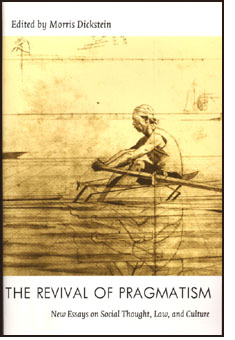
For
another discussion of American painting and culture by Ray Carney,
see: "When Mind is a Verb: Thomas Eakins and the Doing of Thinking,"
in Morris Dickstein (ed.) The Revival of Pragmatism: New Essays
in Social Thought, Law, and Culture (Durham, NC: Duke University
Press, 1998), 5 photographs, paperback, 464 pages. This book
is available directly from this site for $25.
Available
through Amazon,
Barnes
and Noble, your local bookseller, or, for a limited time, directly
from the author (in discounted, specially autographed editions).
See below for information
how to order this book directly from the author by money order,
check, or credit card. Clicking
on the above links will open a new window in your browser. You may
return to this page by closing that window or by clicking on the
window for this page again. |
|
|
|
For
more information about the life and work of Mike Leigh:
  |
|
Ray
Carney's The Films of Mike Leigh is quite simply the best
book of film criticism I have ever read.
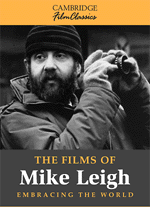 Now I have to say that
I have never read any of Carney's other books (he has also written
books on Cassavetes, Frank Capra, and Carl Dreyer), which, for all
I know, might be even better. But as a friend of mine put it, 'His
writing blows everything else out there away, even to the point
of many times seeming like simply in a class of his own...different
in kind more than degree.' And although I admit to not having read
'everything else out there,' I feel the exact same way. Ray Carney's
new book has undeniably rocked my world. Now I have to say that
I have never read any of Carney's other books (he has also written
books on Cassavetes, Frank Capra, and Carl Dreyer), which, for all
I know, might be even better. But as a friend of mine put it, 'His
writing blows everything else out there away, even to the point
of many times seeming like simply in a class of his own...different
in kind more than degree.' And although I admit to not having read
'everything else out there,' I feel the exact same way. Ray Carney's
new book has undeniably rocked my world.
Ray Carney's book is
to what usually passes for film criticism what Mike Leigh's movies
are to what, in Hollywood, usually passes for filmmaking: a truly
radical critique, a whole different animal, and a solitary voice
of sanity that has somehow miraculously managed to make itself heard
over the noise and hullabaloo of this culture's present-day insanity.
|
|
--Caveh
Zahedi, creator of A Little Stiff and I Don't Hate Las Vegas
Anymore,
in a review in Filmmaker Magazine |
|
|
Ray Carney, The Films
of Mike Leigh: Embracing the World (New York and Cambridge: Cambridge
University Press, 2000), 13 illustrations, paperback, 290 pages. This
book is available directly from the author for $20.
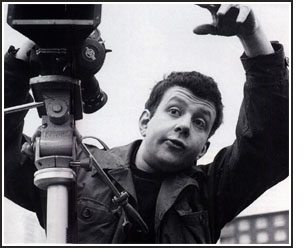 Mike
Leigh is a maverick British independent who, for nearly 30 years, has
been producing eccentric, unique, and almost uncategorizable works. Though
his career dates back to 1971, with a film called Bleak Moments,
Leigh has worked in obscurity for most of that time, coming to the attention
of an international audience only with his recent productions of Naked,
Secrets and Lies, Career Girls, and Topsy Turvy. Mike
Leigh is a maverick British independent who, for nearly 30 years, has
been producing eccentric, unique, and almost uncategorizable works. Though
his career dates back to 1971, with a film called Bleak Moments,
Leigh has worked in obscurity for most of that time, coming to the attention
of an international audience only with his recent productions of Naked,
Secrets and Lies, Career Girls, and Topsy Turvy.
Working in a similar way to
that of Robert Altman, John Cassavetes, and Tom Noonan, Leigh begins with
a small group of actors around whom he builds his films during months
of private rehearsal. There is no script at the start. It is written as
he goes along.
The films--which include Abigails
Party, Meantime, Home Sweet Home, High Hopes,
and Life is Sweet--are brilliant, outrageous, iconoclastic--and
hilarious. Leigh's work has been both ridiculed by some and celebrated
by others as among the greatest filmmaking of the twentieth century.
This study argues, among other
things, that part of the misunderstanding of Leigh's work has been the
result of misclassifying him as a British "realist" in the tradition
of Osborne and Loach, when in fact his films are far stranger and more
artistically daring. The Films of Mike Leigh: Embracing the World
makes the case for regarding Leigh as one of the great artists of the
century.
This is the first comprehensive
critical appreciation of Leigh's work ever written, and it offers insights
not only into this unusual filmmaker's strange and often baffling movies,
but into film itself as a way of knowing and understanding the world.
This book offers nothing less than a radically new way of understanding
both life and art.
To read reviews and critical responses to Ray Carney's The Films of Mike Leigh, click here.
This book is available
through Amazon,
Barnes
and Noble, your local bookseller, or, for a limited time, directly
from the author (in discounted and specially autographed editions). Advance
copies may be ordered now. If you order prior to publication, your "first
edition" copy will be mailed to you the day the book becomes available
(and before it is generally available in bookstores) |
|
* * *
Ray
Carney, American Vision: The Films of Frank Capra (Hanover, N.H.
University Press of New England, 1996), 88 illustrations, paperback, 510
pages. This book is available directly from the author for $20.
 The
first interdisciplinary study of America's best-known filmmaker. In this
daring and unorthodox study, Ray Carney places the work of Frank Capra
in the great tradition of American transcendentalism--along with paintings
by Homer, Eakins, Sargent, Hopper and the writings of Emerson, Poe, Hawthorne,
and William and Henry James, among others. The
first interdisciplinary study of America's best-known filmmaker. In this
daring and unorthodox study, Ray Carney places the work of Frank Capra
in the great tradition of American transcendentalism--along with paintings
by Homer, Eakins, Sargent, Hopper and the writings of Emerson, Poe, Hawthorne,
and William and Henry James, among others.
Interweaving wide-ranging discussions
of American literature, drama, and painting and the work of other filmmakers
with detailed analyses of such films as Its a Wonderful Life,
Meet John Doe, and Mr. Smith Goes to Washington, Carney
finds in Capras life and work a classic American struggle for self-expression
within the repressive structures of ordinary life. In this larger cultural
context, Capra emerges as something far more radical than the social realist
he is often taken to be--as a visionary determined to unleash "mysterious,
distinctive, personal energies that defy social understandings or control."
American Vision was
reprinted in 1996 with a new Preface outlining recent developments in
Capra criticism, and detailing the shortcomings of current Cultural Studies
approaches to his work.
For reviews and critical responses
to American Vision: The Films of Frank Capra, please click
here. (Use your back button to return to this page.)
This book is available through Amazon,
Barnes
and Noble , your local bookseller, or, for a limited time, directly
from the author (in discounted and specially autographed editions). See
below for information how to order this book directly from the author
by money order, check, or credit card. Clicking
on the above links will open a new window in your browser. You may return
to this page by closing that window or by clicking on the window for this
page again.
* * * |
| If you order
directly from the author, also included will be a copy of Ray Carney's
"Learning from Dreyer: Reflections on the Lessons His Work Teaches,"
which originally appeared in Lene Crone and Lars Movin, eds. Close-Ups:
Contemporary Art and Carl Th. Dreyer, Nikolaj, Copenhagen Contemporary
Art Center (Copenhagen, Denmark, November-December 1999). |
|
For
more information about the life and work of Carl Dreyer:
Ray
Carney, Speaking the Language of Desire: The Films of Carl Dreyer
(New York and Cambridge: Cambridge University Press, 1989), 50 illustrations,
paperback, 365 pages. This book is available directly from the author
for $20 in a Xeroxed bound copy of the original published book edition.
(The book itself is now out of print, but a bound Xerox copy will be
sent.)
 Although
Carl Dreyer is universally acknowledged to be one of the supreme masters
of world cinema, it is one of the oddities of film history that beyond
The Passion of Joan of Arc, his films have seldom had the general
recognition that they undeniably deserve. This book is an attempt to bring
his work to the awareness of contemporary filmgoers everywhere. Although
Carl Dreyer is universally acknowledged to be one of the supreme masters
of world cinema, it is one of the oddities of film history that beyond
The Passion of Joan of Arc, his films have seldom had the general
recognition that they undeniably deserve. This book is an attempt to bring
his work to the awareness of contemporary filmgoers everywhere.
Ray Carney argues that the
key to an understanding of Dreyers work is to be found in an appreciation
of his distinctive style. Professor Carney argues that Dreyers style
creates a "radically new way of knowing and feeling" that can
change how we understand our experiences and identities outside of the
movies.
Following a general consideration
of Dreyers style, the book offers lucid and comprehensive interpretations
of the three crowning masterworks of Dreyers career: Day of Wrath,
Ordet, and Gertrud.
The study will appeal both
to general filmgoers and to undergraduate and graduate students interested
in film.
Click
here to read reviews
and appreciations of Ray Carney’s Speaking
the Language of Desire.
This book is available through
Amazon, your local bookseller, or, for a limited time, directly
from the author (in discounted and specially autographed editions).
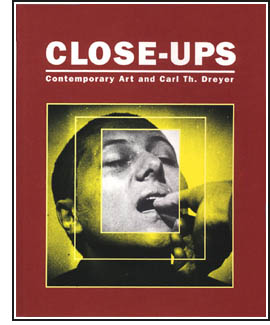
Clicking on the above links
will open a new window in your browser. You may return to this page by
closing that window or by clicking on the window for this page again.
* * * |
| For
more information about Ray Carney's writing on the Beat Movement: |
|
Lisa
Philips, ed. Beat Culture and the New America—1950-1965 (Paris
and New York: The Whitney Museum of Art in association with Flammarion,
1995) softcover, copiously illustrated with more than 300 photos, 280
pages.
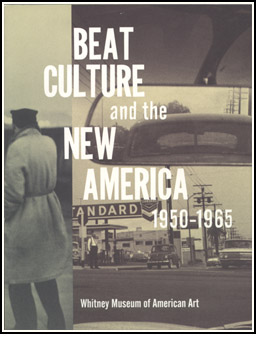 Beat
Culture and The New America: 1950-1965 puts the cultural legacy of
the Beat generation into the context of the social and artistic ferment
of the 1950s and early 1960s. This, the catalogue that accompanies the
show at the Whitney Museum, surveys a vast range of artistic practices--from
painting, sculpture, photography, to film, and a fascinating range of
documents and Beat ephemera. The book goes far beyond defining what Beat
was and was not, what it spawned or what it ignored. Whitney curator Lisa
Phillips, who conceived and organized the exhibition, and the nine contributing
writers to this catalogue [which includes three new pieces by Beat film
expert Ray Carney] have set out to define not only the historical roots
of Beat culture, but also the relationship between its fuzzy edges and
its molten center. Just as important, the show and catalogue clarify the
bridge between the current range and tone of American art, music, and
literature and the residual forces which initially emerged during this
complex moment in postwar American history and remain very much with us
today. Beat
Culture and The New America: 1950-1965 puts the cultural legacy of
the Beat generation into the context of the social and artistic ferment
of the 1950s and early 1960s. This, the catalogue that accompanies the
show at the Whitney Museum, surveys a vast range of artistic practices--from
painting, sculpture, photography, to film, and a fascinating range of
documents and Beat ephemera. The book goes far beyond defining what Beat
was and was not, what it spawned or what it ignored. Whitney curator Lisa
Phillips, who conceived and organized the exhibition, and the nine contributing
writers to this catalogue [which includes three new pieces by Beat film
expert Ray Carney] have set out to define not only the historical roots
of Beat culture, but also the relationship between its fuzzy edges and
its molten center. Just as important, the show and catalogue clarify the
bridge between the current range and tone of American art, music, and
literature and the residual forces which initially emerged during this
complex moment in postwar American history and remain very much with us
today.
—Excerpted (and adapted)
from the "Director's Foreword" by David Ross
This book sold out all of its
printings and is now only available in libraries, used book stores, and
through the used book service of Barnes and Noble (which has many copies
of it at different prices). For more information about the Beat movement,
I highly recommend the following web sites:
Clicking on the above links
will open a new window in your browser. You may return to this page by
closing that window or by clicking on the window for this page again.
* * *
Your Life is a Movie: Alternative Visions of Film, Media, and Culture
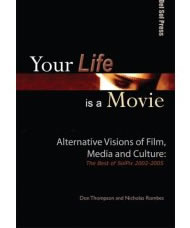 A book containing interviews with: Ray Carney, Rob Nilsson, and Kayoko Mitsumatsu, and essays by: Todd Gitlin, Timothy Dugdale, Patricia Ducey, Nicholas Rombes, Eric Alterman, Don Thompson, Mike Shen, T. B. Meek, and Michael Neff. A book containing interviews with: Ray Carney, Rob Nilsson, and Kayoko Mitsumatsu, and essays by: Todd Gitlin, Timothy Dugdale, Patricia Ducey, Nicholas Rombes, Eric Alterman, Don Thompson, Mike Shen, T. B. Meek, and Michael Neff.
This book contains one of the longest, most detailed, and far-ranging interviews Prof. Carney has ever given. Ray Carney's book-length interview with Shelley Friedman, which took place over a period of weeks and runs almost 30,000 words, covers a range of topics--from problems with journalistic film reviewing, to how the worship of money, power, and celebrity in America distorts film appreciation, to the function of film festivals, to the deficiencies of academic film study and the purpose of film school. Professor Carney also gives his views on influential recent filmmakers like Quentin Tarantino, Wes Anderson, David Lynch, Neil LaBute, Andrew Bujalski, and Caveh Zahedi.
This book may be obtained at Amazon by clicking here, or special ordered at any bookstore.And note that the entire text of this interview is also included in Prof. Carney's "Necessary Experiences" packet, which is for sale on this page. Click here to go there.
|
|
These
books may be bought through the web sites listed above, or obtained directly
from the author, by using the Pay Pal Credit Card button below, or by
sending a check or money order to the address below. However you order
the book or books, please provide the following information:
* Your name and address
* The title of the book you are ordering
* Whether you would like an inscription or autograph on the inside front
cover
Checks or money orders may be mailed to:
Ray Carney
Special Book Offer
College of Communication
640 Commonwealth Avenue
Boston University Boston, MA 02215
|

|
Credit
Card
|
| NEW! |
| Now
you can buy Ray Carney's works online using Visa or MasterCard. |
|
Note:
If you pay by credit card using the PayPal button, please note in
the item description or comments section of the order form the exact
title of the item or items you are ordering (be specific, since
many items have similar titles), as well as any preferences you
may have about an autograph or inscription and the name or nickname
you would like to have on the inscription.
If you are confused
by the PayPal form, or unsure where to enter this information, you
may simply make your credit card payment that way, and separately
email me (at the address below) any and all information about what
item you are ordering, and what inscription or name you would like
me to write on it, or any other details about your purchase. I will
respond promptly.
The PayPal form has
a place for you to indicate the number of items you want (if you
want more than one of any item), as well as your mailing address.
If you place your order
and send your payment by mail, please include a sheet of paper with
the same information on it. I am glad to do custom inscriptions
to friends or relatives, as long as you provide all necessary information,
either on the PayPal form, in a separate email to me, or by regular
mail. (Though I cannot take credit card information by mail; PayPal
is the only way I can do that.)
If you want to order
other items from other pages, and are using the PayPal button, you
may combine several items in one order and have your total payment
reflect the total amount, or you may order other items separately
when you visit other pages. Since there is no added shipping or
handling charge (shipping in the US is free), you will not be penalized
for ordering individual items separately in separate orders. It
will cost exactly the same either way.
These instructions apply
to American shipments only. Individuals from outside the United
States should email me and inquire about pricing and shipping costs
for international shipments.
Clicking on PayPal opens
a separate window in your browser so that this window and the information
in it will always be available for you to consult before, during,
and after clicking on the PayPal button. After you have completed
your PayPal purchase and your order has been placed, you will automatically
be returned to this page. If, on the other hand, you go to the PayPal
page and decide not to complete your order, you may simply close
the PayPal window at any point and this page should still be visible
in a window underneath it.
If you have questions,
comments, or problems, or if you would like to send me additional
information about your order, please feel free to email me at: raycarney@usa.net.
(Note: Due to the extremely high volume of my email correspondence,
thousands of emails a week, and the diabolical ingenuity of Spammers,
be sure to use a distinctive subject heading in anything you send
me. Do NOT make your subject line read "hi" or "thanks"
or "for your information" or anything else that might
appear to be Spam or your message will never reach me. Use the name
of a filmmaker or the name of a familiar film or something equally
distinctive as your subject line. That is the only way I will know
that your message was not automatically generated by a Spam robot.)
Problems? Unable to access
the PayPal site? If you are having difficulty, it is generally because
you are using an outdated or insecure browser. Click
here for help and information about how to check your browser's
security level or update it if necessary. |
|
|










